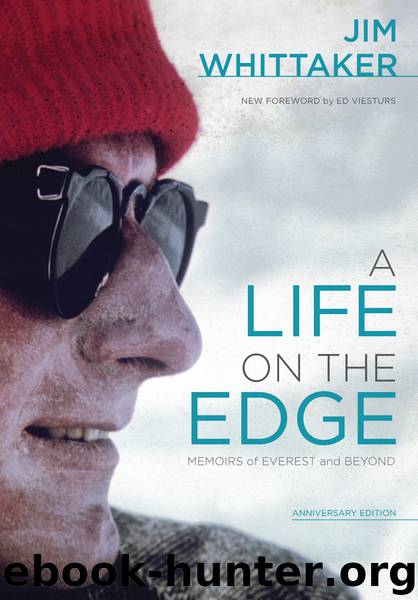A Life on the Edge by Jim Whittaker

Author:Jim Whittaker
Language: eng
Format: epub
Publisher: The Mountaineers Books
Throughout these years, both before and after Blanche and I divorced, I buried myself in work at REI, in part to avoid my unhappiness at home. Here, at least, my efforts bore fruit.
Not long after I returned from the Everest expedition in 1963, we finally closed the old second-floor walk-up store on Pike Street and moved into a wonderful old warehouse building on Capitol Hill. At last we had a street-level storefront. The interior of the warehouse perfectly suited REI’s rugged image: high ceilings, massive old fir beams, concrete and brick walls, and a worn, creosote-hardened industrial wood floor. Compared to our original location, the new store was vast; even so, we soon needed the entire second floor of the building for our mail-order business.
We were growing very quickly. We set up our own testing department to ensure the reliability of the equipment we sold. We hired climber and engineer Carl Magnussen to run the department, and we tested everything, paying special attention to carabiners, slings, pitons, ropes, ascenders, and other climbing equipment. It was no exaggeration that our customers’ lives depended on the quality of the gear we sold them.
We also advanced the retailing concept of “private label” goods—that is, we not only retailed things other people manufactured but we also manufactured some of our own products. For example, in the early days, I had relied on a now-famous, but then quite small, company called Eddie Bauer for our down clothing and sleeping bags. I had even used their products on Everest. When they decided to become direct retailers themselves, we decided to become manufacturers. Lloyd Anderson and I entered into an equal partnership with George Trager and John Hartsfield, whose Trager Manufacturing already produced gaiters, rucksacks, and backpacks that fit on our own aluminum pack frames. We formed a new company I called THAW (using the first letters of our last names) to produce our own down products. This not only gave us greater control over product quality but also eliminated a middleman, permitting us to capture more of the profit while still offering our customers a lower price than if we were buying from a wholesaler. THAW did very well, and eventually REI bought out Trager and Hartsfield, making both of them a lot of money in the process.
By 1965, the year I led Bobby up to the summit of Mount Kennedy, REI had its first million-dollar year; sales reached $1.3 million, and we had fifty thousand members. Between 1965 and 1968 our sales more than tripled, reaching $4 million, and membership doubled, to more than one hundred thousand. By 1970, when Blanche and I separated, REI’s sales had reached $7.5 million. On New Year’s Day, 1971, I became president and chief executive officer of REI (Lloyd had retired), and by the end of that year our sales had leaped to $10 million, and we had a quarter of a million members.
It was at this point that I began wondering about the cost of our success to the very thing we loved the best: the outdoors.
Download
This site does not store any files on its server. We only index and link to content provided by other sites. Please contact the content providers to delete copyright contents if any and email us, we'll remove relevant links or contents immediately.
Endurance: Shackleton's Incredible Voyage by Alfred Lansing(4508)
Tokyo Vice: An American Reporter on the Police Beat in Japan by Jake Adelstein(3866)
The Motorcycle Diaries by Ernesto Che Guevara(3788)
Alive: The Story of the Andes Survivors by Piers Paul Read(3731)
Exit West by Mohsin Hamid(3636)
Apollo 8 by Jeffrey Kluger(3514)
Aleister Crowley: The Biography by Tobias Churton(3427)
Annapurna by Maurice Herzog(3301)
Full Circle by Michael Palin(3269)
Into Thin Air by Jon Krakauer(3132)
Kitchen confidential by Anthony Bourdain(2834)
In Patagonia by Bruce Chatwin(2757)
A Wilder Time by William E. Glassley(2690)
Finding Gobi by Dion Leonard(2635)
Into the Wild by Jon Krakauer(2508)
The Ogre by Doug Scott(2506)
L'Appart by David Lebovitz(2395)
The Stranger in the Woods by Michael Finkel(2328)
An Odyssey by Daniel Mendelsohn(2206)
